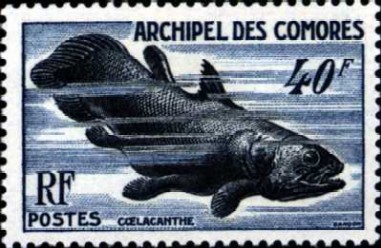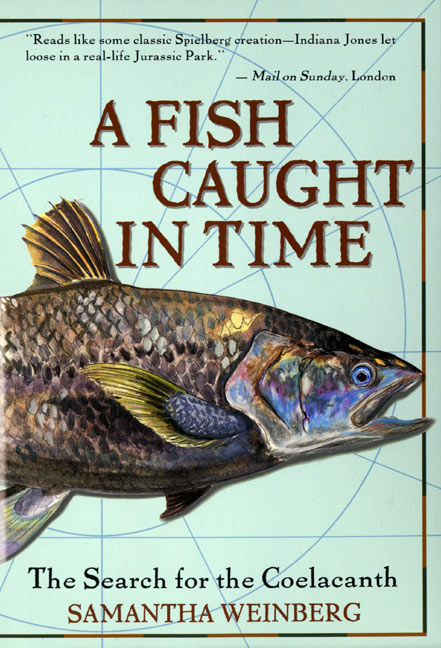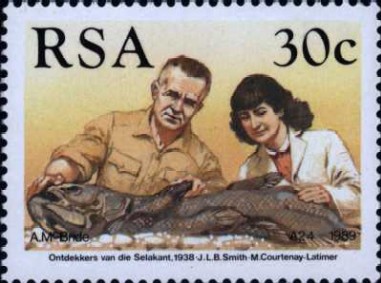Pondering the Coelacanth Curse
Posted by: Loren Coleman on December 20th, 2008

“The coelacanth (Latimeria chalumnae) is the darling of cryptozoology, a true living fossil. Its story demonstrates that unknown, undiscovered, or at least long-thought-extinct animals can still be found – especially in the oceans.” – – from The Field Guide to Lake Monsters, Sea Serpents, and Other Mystery Denizens of the Deep .

The travel writer and James Bond novelist Samantha Weinberg, author of the bestseller A Fish Caught in Time: The Search for the Coelacanth has written a short but remarkably detailed article in The Daily Mail about the modern history of the discovery of the coelacanth. (Sadly, as the cover of one edition of her book sadly demonstrates, not all book cover designers know exactly what a coelacanth looks like!)
The core of Weinberg’s essay is the decidedly surprising highlighting of the fact there have been several searchers’ deaths tied to the quest for the coelacanth.
We are approaching the 70th anniversary of the first modern finding and verification of this unique and often mistakenly labeled “prehistoric” fish. Of course, the coelacanth is a thoroughly modern species but it has been hidden from the West for 65 million years, it seems.
On December 23, 1938, Hendrik Goosen, the captain of the Nerine returned to the harbor at East London after trawling near the mouth of the Chalumna River, and he called Marjorie Courtenay-Latimer, the curator of the small local museum, to look over his catch. She found the coelacanth in the fish pile, felt it was a beautiful fish, and the rest is history.
Courtenay-Latimer had discovered the coelacanth when she matched it in a book, and had her finding confirmed formally by Dr. JLB Smith.

Smith and Courtenay-Latimer later celebrated the second discovery of the coelacanth, finally found on Christmas Eve, 1952. Smith had received a telegram from an English sea trader named Eric Hunt, informing him that a curious-looking fish had been spotted in a market in the Comoros, which he suspected might be what the naturalist had been hunting for during the last 14 years.
Weinberg notes the following deaths tied to the coelacanth’s history of discovery. Her sentences (edited together here from her long article) make for a chilling legacy:
After an illustrious career as South Africa’s most revered scientist, Smith [died by] suicide in 1968, when he felt his mental faculties beginning to fade.
And Eric Hunt, the English sea captain who had landed the Comoros specimen, died in a shipwreck in 1956….
In 1998, a professional diving trainer name Riaan Bouwer was searching for coelacanths in the deep water off Sodwana Bay in South Africa, determined to be the first diver to see them….Tragically, Bouwer’s equipment malfunctioned, forcing him to attempt a rapid ascent to the surface. He never made it. Because his body hadn’t decompressed sufficiently, it sank back down and was never recovered….
On November 27, 2000, [three South African deep-water divers] dived down to 115 metres….Twelve minutes into their dive they got lucky: they found and filmed three coelacanths, all hovering in such a way that it made them seem as if they were standing on their heads.
The dive team were thrilled – but in a bizarre repeat of the earlier tragedy, disaster struck again. One of the team’s cameramen lost consciousness, forcing his diving buddy, Dennis Harding, to rush him to the surface. From a depth like that, a safe ascent should take around two hours. They had to do it in minutes.
The two men made it to their boat, but after helping his buddy on board, Harding started to complain of neck pains. Shortly afterwards, he died from a massive cerebral embolism brought on by his rapid ascent.
The curse of the coelacanth had struck again – just as it would do the following year, when yet another diver, Erna Smith, died in the same waters while practising for another coelacanth expedition.
In three years, then, the coelacanth had claimed the lives of three divers.
~Samantha Weinberg
Is there anything to Samantha Weinberg’s view that the coelacanth has experienced an unlucky quest? (For the rest of her Daily Mail article, see here.)
Certainly, Marjorie Courtenay-Latimer was not touched by the curse, please note, as she lived a long (but reportedly very lonely) life from February 24, 1907, until she passed away on May 17, 2004.
Needless to say, I celebrate the coelacanth in my museum’s logo (below), and enjoy seeing this imagery of this big “darling of cryptozoology” everyday. I wish everyone a happy and safe holiday season.

About Loren Coleman
Loren Coleman is one of the world’s leading cryptozoologists, some say “the” leading living cryptozoologist. Certainly, he is acknowledged as the current living American researcher and writer who has most popularized cryptozoology in the late 20th and early 21st centuries.
Starting his fieldwork and investigations in 1960, after traveling and trekking extensively in pursuit of cryptozoological mysteries, Coleman began writing to share his experiences in 1969. An honorary member of Ivan T. Sanderson’s Society for the Investigation of the Unexplained in the 1970s, Coleman has been bestowed with similar honorary memberships of the North Idaho College Cryptozoology Club in 1983, and in subsequent years, that of the British Columbia Scientific Cryptozoology Club, CryptoSafari International, and other international organizations. He was also a Life Member and Benefactor of the International Society of Cryptozoology (now-defunct).
Loren Coleman’s daily blog, as a member of the Cryptomundo Team, served as an ongoing avenue of communication for the ever-growing body of cryptozoo news from 2005 through 2013. He returned as an infrequent contributor beginning Halloween week of 2015.
Coleman is the founder in 2003, and current director of the International Cryptozoology Museum in Portland, Maine.










A hundred fifteen meters is really pushing the limit for divers using scuba-type systems. It’s hardly surprising there were deaths resulting from those efforts. (While very dedicated experts with modified equipment have pushed deeper, thescubaguide.com says “The safety limit for a trained expert diver should be around 200 feet.”)
So it’s the depth and not the fish that get the blame: it would have been the same if they were trying to film “a misshapen rock cod” (which might have been the inspiration for Weinberg’s cover artist) or whatever.
Myself, I don’t belive in a curse…
I have to say, the Coelacanth was what got me really excited about cryptozoology. I always get a little happy when I see articles about that very special fish.
Do I think there’s a curse? No, I think it’s rubbish.
Happy Holidays to you, too!
Like you, Loren, I have long been fascinated by the Coelecanth. If I remember correctly (hardly a sure thing), aren’t most of the fossil specimens much smaller than the living species?
I picked up A Fish Caught In Time by chance in London during one of my “must-find-book-to-read-on-plane-trip” purchases, roughly at the time it was published. I thoroughly enjoyed it and still read the odd chapter once in a while.
I have always loved the Coelacanth’s story. Back then I was hoping to study Marine Biology (ended up doing Environmental Biology due to grades) and it was hard to ignore such a find.
And yes, I too do not believe this is a cursed subject. Diving to such depths involves enormous amounts of danger to even the most highly skilled Nitro divers so it is not peculiar that there have been so many unfortunate losses. People make mistakes, technology falters no mater how well one checks it. Something goes wrong at that depth…the chances of saving the situation are slim at best. If people did not take chances we would not know half the things we do today.
Deep sea diving is very dangerous. No there is no curse, just risks.
Ceroill, there was once a very differse radiation of coelacanths, some very small ones, some medium sized, some as big as modern coelacanths, but some also much bigger, like the huge Mawsonia. There are of course much more ecological niches for small fish, what´s most probably one of the main reasons, why many of the ancient coelacanths were not very big.
I enjoyed reading the well written essay in the mail and am convinced more of this sort of thing should be in a newspaper and would increase interest and sales! No curse though or any reason for it, just bad luck and maybe because it is extra special, more risks being taken.
Wonderful and perfect thing this coelacanth and its discovery. I hope it is not really a ”thoroughly modern fish” wouldn’t that rather defeat the object? Think dragon fly!
Looks if the argument in favour of homo floresiensies is being won. Doesn’t this equal the discovery of the coelecanth and shouldn’t we all be getting excited and reveling in our luck to see it happen?